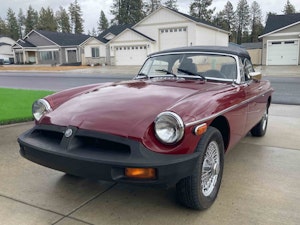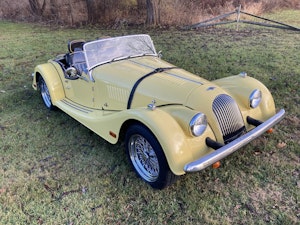Media | Articles
Sometimes, Movie Cars Are Wrong For a Reason
This article first appeared in the May/June issue Hagerty Drivers Club magazine. Join the club to receive our award-winning magazine, and as part of the first-ever HDC Days from June 21 to June 23, Hagerty Drivers Club members will be eligible for some amazing deals, cool contests, and epic events and experiences. Not an HDC member? Sign up today!
An old college friend stopped in a few weeks ago, and over beers, he started ranting about cars in movies. He had just watched a recent period pic called The Hill about a disabled boy who overcomes adversity to play baseball and, while he liked the film, he was put off by some apparently flagrant mismatches between the 1960s time period and the cars. His rant building steam, Jeff went on: “Somebody needs to tell these directors that if the scene is in 1965 and a guy who is supposed to be somebody pulls up in a shiny ’59 Cadillac, it’s wrong! Back then, nobody drove around in a six-year-old Cadillac if they could afford a new one!”
His point might be picayune and it may only matter to a small minority of the viewing audience—the ones married to spouses who are always shushing them to be quiet and stop going on about that one green Beetle that keeps reappearing in the Bullitt chase sequence—but he’s not wrong. Cars are important to film because they are the one prop that instantly dates a scene. If the cars have high roofs, wheel spats, and bustlebacks, you’re in the 1930s or ’40s; chrome swaddling and tailfins, the 1950s; straight edges, the 1960s; landau tops and pea green paint, the 1970s. Used correctly, old cars efficiently and effectively transport us as well as the characters back in celluloid time. Used badly, and it’s like watching Napoleon pull out an iPhone to find Waterloo. It takes you right out of the moment. People are still complaining about those kit Cobra replicas with the modern mag wheels that appeared in Ford v Ferrari.
I called Jamie Kitman, a man of seemingly a dozen careers, including writing for this magazine as well as running a business that procures cars for film shoots. I asked him why directors often seem to pick the wrong cars. Do they not care or do they just not know any better? A bit of both, was his answer, and money can dictate what four-wheelers get cast. A lot of people involved in production have very strong opinions, and, “some of them know what they’re talking about, some of them don’t,” he said. “And some are constrained budgetarily or logistically, or they’re shooting in a place that doesn’t have a wide supply of cars readily available.”

The better productions can afford to be accurate where cars are concerned, he went on. “I worked on [The Marvelous] Mrs. Maisel, which was all about its cars, and they were pretty sensitive to the cars being right. The propmaster knew enough to know there was a right and a wrong.” However, Kitman often finds himself confronting blunt stereotyping about what a particular era was like (no, not everybody drove triple-tone pastel tailfin cruisers on whitewalls in the ’50s) or a simple lack of knowledge about cars. Once, a producer called Kitman wanting an MG TC for a scene, and Kitman was able to match her up with a car. “Then, three days before the shoot, she called and said, ‘Just checking; it’s an automatic, right?’ And we said no, and she said, ‘Can you find me an automatic one?’ And we said no, automatic MGs didn’t exist in 1948. And she said, ‘Well, can you make it an automatic?’” Of course, said Kitman, if you give me a month and $30,000. “So they said never mind. That’s the sort of thing that happens.”
Kitman can find himself immersed in the details of the characters. “Occasionally you’ll find yourself saying, ‘Based on what you’ve told me about the character, what you’re asking for is completely wrong.’ And they may or may not hear me.” A big challenge is scenes set in Europe but filmed in America. Since the 1970s, the cars imported into the U.S. have tended to be the larger models, not the small hatchbacks that carpet European roads, and “they often have really big bumpers, which is a dead giveaway to the cognoscenti.” So Kitman keeps a ready supply of small, plebeian Euro-gerbils for such scenes, though sourcing right-hand-drivers is always a challenge. “We’ve had double-decker buses towed from the Carolinas to be in TV shows,” he told me.
The takeaway: If car flubs happen on screen, don’t assume it’s just because the director doesn’t know a tailfin from a turbo. Sometimes they can’t afford or can’t find exactly what would be correct. And sometimes, as in the case of Bullitt, Smokey and the Bandit, and a few others, the cars deserve their own Academy Awards.
***
Check out the Hagerty Media homepage so you don’t miss a single story, or better yet, bookmark it. To get our best stories delivered right to your inbox, subscribe to our newsletters.
Marketplace
Buy and sell classics with confidence













As a kid, one of the times I laughed watching Hogan’s Heroes on TV was the appearance of an early-’50s Ford truck in a scene…my point being, sometimes these gaffes are simply funny on their own, like contrails or tire marks in old westerns, or a boom mic visible at the top of the screen. The moving screens in the driving scenes of It’s A Mad (etc) World are hysterical. But yeah, getting the cars wrong is a source of gleeful derision to many of us, and when they get it right, it definitely adds credibility.
Another point… In films set in the ’30s, two-thirds of the cars are Model As…nary a Chevy, Dodge or Nash in sight. Also, there is a preponderance of convertibles…. all shiny with dual side mounts, quail radiator caps and wind wings.
When I lived in Abilene , Texas, A friend had a well worn Model A pick up. It might of had original paint. It was presentable but not a show car.
A few years before, Clint Eastwood directed a film in a small town nearby.
He selected the pickup to be the driven by a main character because it looked the part of what someone in rural Texas in the ’30s would drive.
It’s always enjoyable to scan for period cars in movies and TV shows as now days so many newer cars look the same, just a different color. Always enjoy seeing the Beetle in Bullitt. Of course, I’m happy to see older cars anywhere.
WW2 movie “25th Hour” (1967) was set in Romania in 1944 starred Anthony Quinn, Virna Lisi and Michael Redgrave.
There’s a major goof in this scene—can you spot it? ( Hint, they used a 1955 Chevy station wagon with wide whitewalls…at least they painted it OD green…..
In the DIck VanDyke show, he sits in a Jeep (debating — please! — whether he should marry Laura or not!) that might not even be a driver; the tires are absolutely bald! In another, they have a spat while driving a late-fifties’ Dodge ragtop, but there aren’t too many cars shown. Leave it to Beaver was a car classic! Besides Lumpy’s sharp ’40 Ford rag, there are lots of others worth seeing. When Wally buys a delelict ’36 Ford five-window, then parts it out for a profit, the prices don’t make sense (with Eddie as the car expert?) but it’s fun!
LOTS of material to comment on here. Minor details like in Bonnie & Clyde, where there is an obviously junked-not-running ’32-33 Ford truck setting the the yard of the farmer/father who nurses B & C back to health; on a 1934-35 DEPRESSION era farm a 1-2 YEAR OLD truck would already be junked? In some movies set in the 40’s-50’s narrow whitewalls (circa 1962 on) are on all the cars. Driving Miss Daisy, she has a black 1955 Cadillac Fleetwood in one scene, next scene is a black 1956 Series 62 Sedan appearing as the same car. Early Perry Mason shows are great for car watching, Perry had to keep switching from Cadillacs to Fords during the years 1957 to 1959 based on the sponsors!
I havern’t had a moment to reflect on all previous comments, but when it comes to mismatched cars and/or their capabilites, just take a look at the Fast and Furious franchise…….especially the Fiero that flies to the moon, but then again…that’s why they call it entertainment I suppose.
Being a Mopar guy, the movie that cracks me up is Joe Dirt. In the movie, the lead, David Spade, calls a ‘67 satellite convertible a Road Runner. If you listen to the version with directors commentary, they refer to the ‘69 Dodge Daytona as a Superbird. C’mon, guys! It’s not that difficult!
My pet peeve is when they are supposed to be driving but the shift lever is definitely in the park location. Why not put the emergency brake on and move to neutral, the car is not running. No chance for an Alex Baldwin mistake.
Every 70s movie or TV show had crap stunts. Jim Rockfords 74 Firebird was always substituted for a 70 when they blew it up. CHIPs always had cars fly in the air when they rear ended someone. Heck in most scene’s you can see the ramp attached to the victim car. In most Police Story shows the cop characters would be driving a Ford LTD in a chase scene, then at the end of the pursuit they pull up in a Plymouth. Even nowadays when a new movie has a retro scene, they get the cars wrong.
Bullitt also had some 68 Firebirds that popped up in a ton of scene in addition to the green Beetle.
Two items I spotted in good or great movies that have bugged me are the following:
1. The Last Picture Show (1971) – One of my all time favorite movies and best picture of the year. However, when the Timothy Bottoms character is taking the Cloris Leachman character to the doctor and back in her husband’s 46 Ford, in the background in one of the seedier sections of Anarene you can see a 1960 Falcon sedan up on blocks. Of course, Bogdonovich wouldn’t have noticed (too busy chasing 19 year old Cybil Shepard around).
2. Ford Vs. Ferrari – I could live with the Cobra replicars, even if the wheels were not spot on. However, after the Shelby character is told by his Dr. he can’t race anymore (circa 1959) he is driving a period correct Aston home and stops at a stoplight. Up behind him rolls up a 1966/67 Plymouth Satellite. For shame…
My simple pet peeve is when the car is an automatic (interior shots, being slammed into park, etc) but when the car takes off down the road the soundtrack is a manual trans shifting gears.
Seeing something newer than would have been on the road at the time the movie is supposed to be in is weird unless it involves time travel. Seeing something older than what would have normally been around isn’t necessarily weird as some people keep cars for awhile or are the 3rd owner, etc.
Highway Patrol!
Dave. Now you’re talking. Broderick Crawford as Dan Mathews could handle anything with a road block.
Interesting back story to Highway Patrol is that Crawford had so many DUI’s that his license was suspended for a long period and you may notice all the scenes of him driving are in remote areas which was private property owned or leased by the studio.
We get Highway Patrol every morning! They always seem to be driving 2 door police cars.